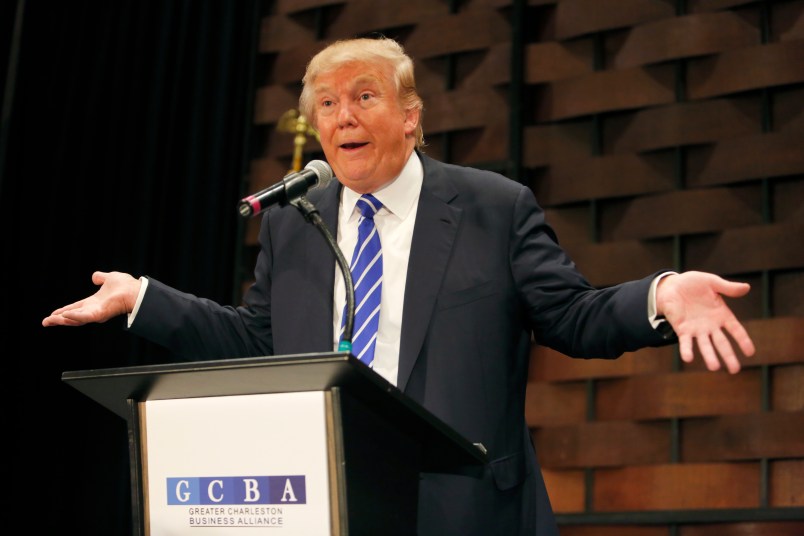We’ve been here before. A frontrunner for the Republican nomination announces a tax plan, which is immediately lauded as “populist” but is actually a massive and unpaid-for tax cut for corporations and the wealthy. Earlier this month, it was Jeb Bush. This week, it is Donald Trump, who seems to have taken Jeb Bush’s plan, given every number a haircut, and submitted it as his own work. So much for being the anti-Establishment candidate.
Put simply, Trump’s plan offers an immense tax cut for the rich, a small tax cut for everyone else, and a multi-trillion dollar hole in the budget. It is as standard-issue Republican fare as the last major Republican tax cut, under George W. Bush, with the same money-for-nothing promises.
Trump’s plan is being promoted as all about closing loopholes. And it does. But the revenue increased from closing loopholes is far outweighed by the revenue lost by lowering tax rates. That’s the fundamental problem with his plan, and why it ends up being a huge boon to high earners.
Take, for instance, the “carried interest” loophole. Trump has put forward the possibility of taxing hedge fund managers’ carried interest as regular income, a loophole worth about $2 billion a year. But other parts of the Trump plan have much bigger price tags, and the vast majority of that money will accrue to wealthy people. For instance, repealing the estate tax, a move that benefits the top 0.2 percent of the population, dwarfs the cost of the carried interest loophole by a factor of ten.
And that’s just the beginning. Trump also wants to slash the corporate tax rate and the income tax rate paid by top earners, and cut taxes on capital gains, even though income from capital gains and dividends are the largest driver of income inequality. As the New York Times’ Josh Barro reports, the Trump tax plan is a “tax cut for the rich, even hedge fund managers.”
The other part of the Trump plan that has the veneer of populism is the across-the-board rate cut. Of course, the bottom 60 percent of the population will only see about 14 percent of the total tax cuts, but still, a family earning around $50,000 a year might get about $2,500 back on their tax bills. Those in the bottom 20 percent of earners would get about $250. Those who recall the George W. Bush tax cuts may be feeling a sense of déjà vu.
A big check in the mail sounds nice, as long as you don’t think about where that money is coming from. As we learned in the early 2000s, most people do not benefit from a tax cut that mostly goes to wealthy people and simultaneously blows the budget to pieces. The result of Trump’s top-heavy tax cuts is a ten trillion dollar hole that Trump has not offered a plan to fill. Strategically, that’s smart. Smaller government is something Americans like in principle, but not in practice. When reminded about the specifics of what government does, Americans often want more money spent, not less. (Want to try and cut a trillion dollars from the budget? The White House tax receipt will show you what that means for spending on health care, education, military families, veterans, the poor, and so on.)
Of course, Trump’s tax plan is fundamentally not very serious; he has released various other tax plans over the months and years that are almost completely at odds with this latest one. Jeb’s largely identical plan has the dubious virtue of consistency with previous Bush tax cuts. Over at Slate, Jordan Weissman has raised the right question: “It will be interesting to see if, like his brother before him, Jeb will be able to market an essentially plutocratic tax plan.”
My own research suggests that this plan is quite marketable, indeed. The American public tends to believe that “loopholes,” not rates, are what affect the taxes paid by wealthy people. As a result, though most Americans approve of a progressive tax system, that support is more muted than it would otherwise be. A substantial amount of support for a flatter, simpler tax system comes from people who think such a system would make wealthy people pay more.
In reality, cutting tax rates at the top saves wealthy people a bundle. But by emphasizing the closure of a few prominent loopholes, Bush and Trump may manage to turn public attention away from the real impact of their tax plans. So far, a fair amount of the media’s coverage has made that misdirection easier.
Vanessa Williamson is a Fellow in Governance Studies at the Brookings Institution and the author of The Tea Party and the Remaking of Republican Conservatism. Her forthcoming book is on American attitudes about taxation.







A frontrunner for the Republican nomination announces a tax plan, which is immediately lauded as “populist” but is actually a massive and unpaid-for tax cut for corporations and the wealthy.
Why the surprise? Trump is attempting to sell the only product that his base is willing to purchase.
There is a much reality in Trump’s promises as in the average “reality TV” show.
Taking a tRump on the poors.
What’s the point of giving the ultra wealthy more money, other than simply running up the score? There is zero economic benefit. Once the GOP has raided the country’s coffers for themselves and their rich enablers, what’s left? What’s the point of all that money if the road you drive your Lamborghini on is full of potholes, and the water where you ride in your yacht is polluted?
Shocking news